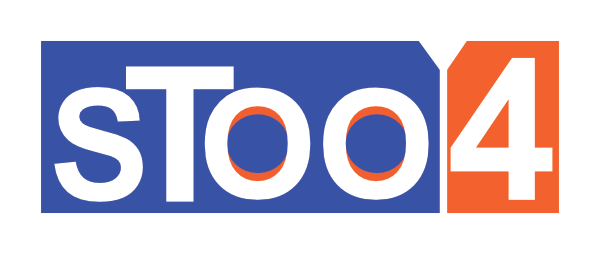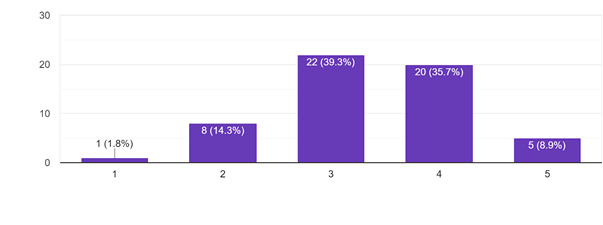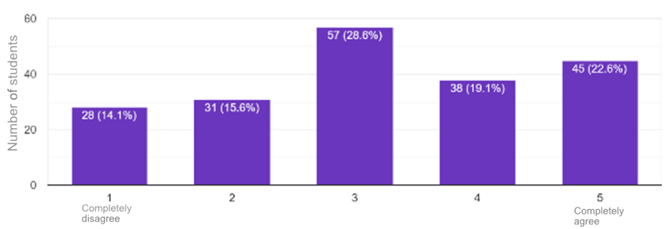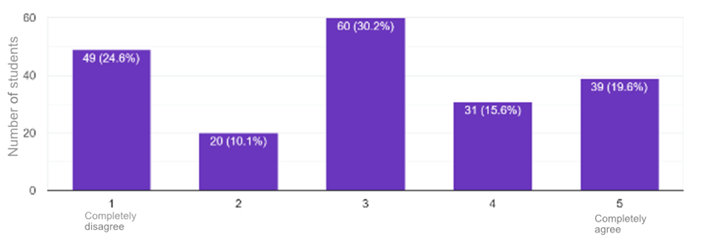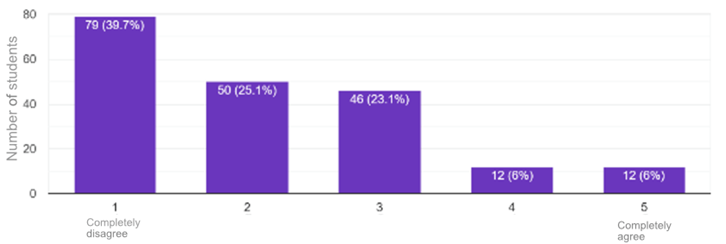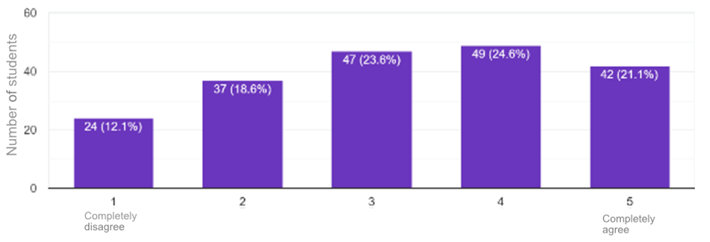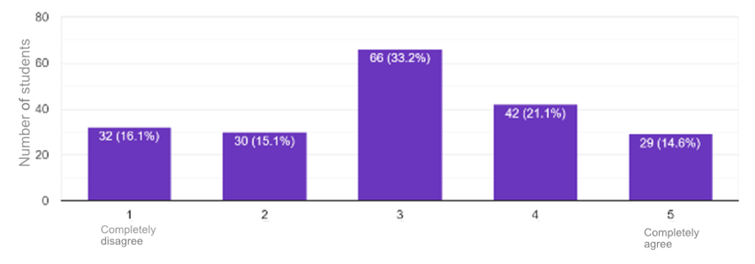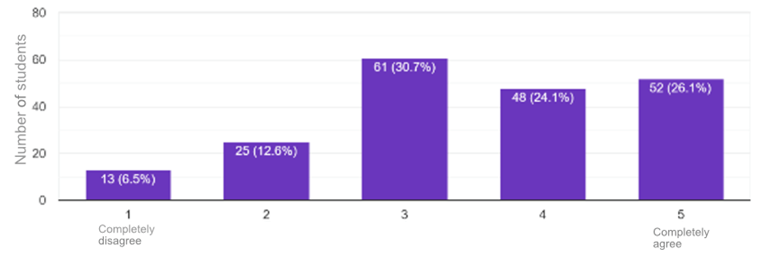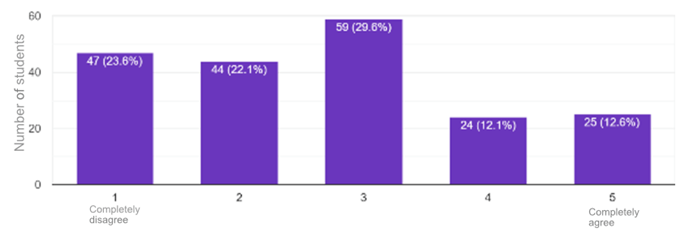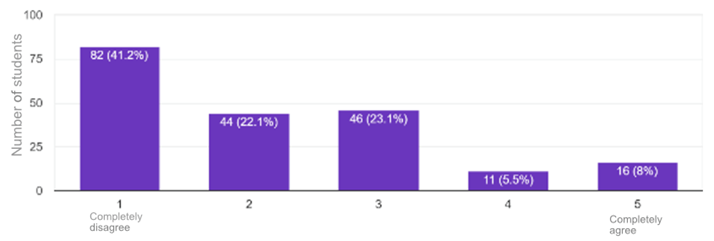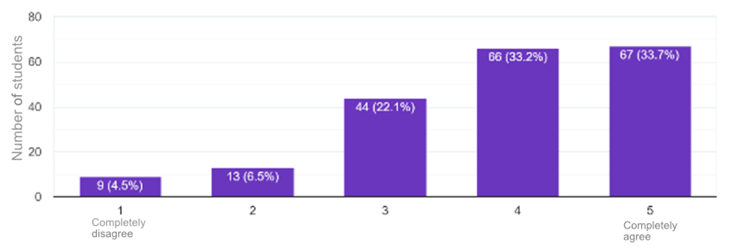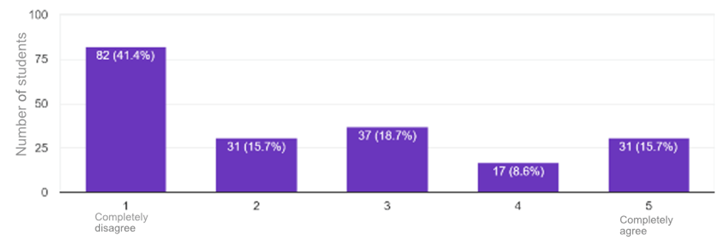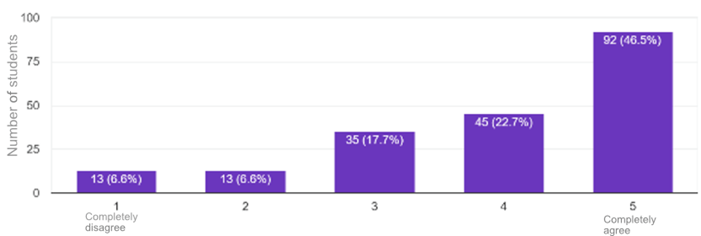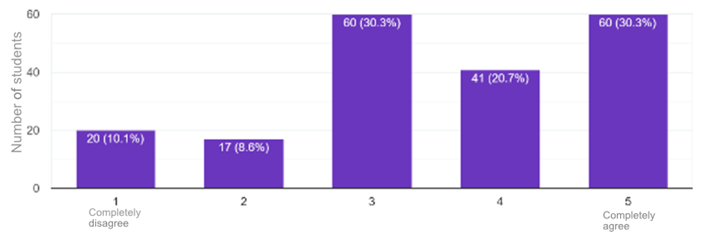ICT In Primary Education – Students’ Perspective
|
Teaching (Today for) Tomorrow: Bridging the Gap between the Classroom and Reality 3rd International Scientific and Art Conference |
|
Pavlina, Ana Pongrac Pavlina, Anita Modrušan
Faculty of
|
|
| Section - Education for digital transformation | Paper number: 1 |
Category: Original scientific paper |
Abstract |
|
This study examines |
|
Key words: |
|
|
Introduction
ArtificialThe Intelligenceintegration of Information and Communication Technology (AI)ICT) into primary education has recently experienced unprecedented growth in many industries, and education is amongrevolutionized the most promising fields for its implementation. Although the potential of AI has been recognized for quite a long time, it is only in the last couple of years that research has shifted more and more towards the effects of AI in the educational field. This increase in interest has occurred alongside the developments in AI technologies like machine learning and natural language processing, which revolutionize education (UNESCO, 2023; World Economic Forum, 2023). In education, the capability of AI to improve teaching and learning cannotprocess, bealigning overemphasizededucation sincewith servicethe deliverydemands hasof beenan personalizedincreasingly digital society. ICT tools, such as interactive whiteboards, digital textbooks, gamified applications, and madeadaptive learning platforms, offer opportunities to make learning more accessible.engaging, In this context, AI refers to systems that can acquireinteractive, and processpersonalized. largeThese amountstechnologies ofnot information,only identifysupport learningcognitive patterns,development but also foster essential 21st-century skills, such as critical thinking, creativity, and providedigital individual learning processes. Learners can also progress through their learning curves and at their learning rate, effectively producing resultsliteracy (AlneyadiDingli et al., 2023; HolonIQ, 2023)(2018)). In addition, ITS, chatbot, and auto-grading solutions can decreaseHowever, the teachers’successful workloadimplementation andof makeICT themin focusprimary moreeducation onrequires addressing significant challenges, including teacher readiness, student attitudes, the inventiondigital divide, and improvement of the creation of meaningful interactions with students and on the development of thinking skills (World Economic Forum, 2023). AI technologies can be used in learning as recommendations in potential development areasinfrastructure and optimizationsupportive of tasks based on a student’s capability. This leads to a situation where even the poor performers and the bright students receive the assistance they require to be productive. Personalized learning platforms have been shown to engage students more effectively, boosting motivation and improving academic outcomes and retention rates (Gningue et al., 2022; Ibrahim et al., 2022). AI can notice that a student requires assistance by analyzing the student’s performance profile. Instead of providing general assistance, it assists where the student is most likely to require help (Alarabi & Wardat, 2021). AI systems can analyze student performance data to identify areas that may require special attention. These systems can help detect struggling learners early and provide support before issues get out of hand. For instance, using big data can track the student’s activity, attendance, and performance to identify those at risk and suggest the appropriate intervention or change in the learning approach (Niall McNulty, 2023). Moreover, other AI systems, such as Mindspark, assess the students’ responses and recommend the right exercises and materials to fill the students’ knowledge gaps and provide each learner with the right level of challenge and support (Calibraint, 2023). AI systems in education can also control the speed of learning, thus allowing fast learners to progress faster while slow learners can progress at their own pace. This learning approach makes it possible for the learner to learn at his or her own pace, depending on his or her ability, making the learning process very effective. For instance, a study reveals that AI can use the student’s performance data to offer feedback and recommend learning resources suitable for the student (Benzakour et al., 2022).
They also assist educators by pointing out students who may require extra attention and assistance. In this case, AI makes it easier to provide targeted support, guaranteeing that every learner gets the help required to succeed (Kurilovas, 2018). In addition, adaptive learning platforms have been integrated into different educational contexts. They have helped students learn at their own pace and enhanced both the interest and the drop-out rates (Chiu et al., 2023).
Harry & Sayudin (2023) highlight that there is a potential for artificial intelligence to change the educational scenario; however, there are specific barriers that require attention for this to happen. It is beneficial as it can personalize lessons for students, reduce administrative tasks for staff, and provide real-time learning updates during class. Still, they have to calculate the benefits and risks, protect information gleaned from students, and control prejudices from AI systems to make integrative authorities feasible. When this comes together with the limitations, AI could make you more efficient and deliver educational help to all-inclusive students. Integrating AI in education is rewarding with several benefits but presents core concerns that have to be strategically resolved. The challenges of data privacy, bias in algorithms, and the feasibility of rolling out AI systems have been factors of great concern. Training affected the AI systems, proving adverse as they replicated the biases in the training data and created gaps in areas such as provision for healthcare services and allocation of resources, including special education for various groups of students (Sutaria 2022). With this, privacy concerns come into play when AI categories together and utilize students' information without consent, raising concerns about surveillance and data usage governance in educational settings (GUJJULA et al., 2023; McNulty, 2023).
Other important factors are ethical considerations such as fairness and accessibility of the content. AI should be developed and deployed in a way that does not reinforce prejudices and provides equal opportunities for all learners. This includes explaining how AI algorithms work and use data (UNESCO, 2023). Constant supervision and assessment are needed to ensure the process is fair and does not perpetuate societal educational inequalities. For example, Baker & Hawn (2022) note that caution is needed when implementing AI in education since it can lead to algorithmic bias that is unfavorable to some students. They recommend the use of diverse data in order to reduce bias in the AI models. Likewise, Chaudhuri & Mohanty (2023) also talk about the need for bias-aware algorithms to capture and address biases that might be inherent in historical data patterns. In this way, institutions can ensure that AI systems are trained on a diverse set of data to reflect the diverse student body. Malik (2024) highlighted the importance of continuously using diverse and representative data and monitoring the AI systems’ performance to create efficient and ethical AI systems.
Furthermore, the UK’s Information Commissioner’s Office (ICO) also notes that fairness in AI is not only a technical concept that refers to algorithmic fairness. It needs a more extensive and context-based approach that takes into account the social and legal consequences of data processing, so that AI does not enhance the existing unfair distribution of resources (ICO, 2023). By implementing these principles, AI systems can be more explainable, non-discriminatory, and inclusive to all students with equal opportunities to access educational materials. There is a great deal of interest and controversy regarding the use of AI in education, as the presence of AI in the educational process increases. Since AI technologies like intelligent learning platforms, automated grading tools, and intelligent tutoring systems are being incorporated into classes, teachers' perceptions of such technologies give insight into the future adoption of AI technologies in education. These perspectives influence the integration and application of AI tools and raise the question of the role of technology in learning contexts.
The aim of this paper is to identify the perception of students from the Faculty of Teacher Education at the University of Zagreb towards the application of Artificial Intelligence (AI) in learning. The research aims to identify the positive and negative attitudes students have towards AI, which subject they think should be supported by AI, and which AI applications are most beneficial for teachers and students. The study, conducted through an online questionnaire, aims to identify prospective primary school teachers’ attitudes toward the benefits and possible drawbacks of AI in the context of teaching practices, as well as their preferences regarding the use of AI tools and technologies in the process of learning and teaching. This study provides a systematic discussion of the possibilities and concerns of AI in the learning environment, and its purpose is to inform the future directions for teacher preparation and policies in integrating AI into primary education responsibly.policies.
Teachers'ICT attitudes toward the use of AItools in education
AI's integration intoprimary education hasare broughttransforming togethertraditional pedagogies by providing diverse and interactive methods for delivering content. Digital platforms and applications offer a range of feelingsmultimedia resources, enabling students to visualize and opinionsinteract fromwith educators,complex which span from optimism to caution. Teachers broadly believe in the benefits of AI, primarily in augmenting personalized learning while, at the same time, lightening administrative work.concepts. For example, AI can provide services that relieve teachers of the burden by automatically providing feedback and monitoring students' progress and automating tasks such as grading, thereby giving the teacher ample time to teach and offer more personalized services. This, according to Kim (2023) and WangSaif et al. (2023),2021) canpresents gohow aaugmented longreality way(AR) inenhances minimizingstudent teacherengagement burdens.and Moreover,comprehension. aAR lotallows of educators believe that AI has the potentialstudents to createmanipulate customizedvirtual models or explore learning experiencescontent, forturning students,abstract allowtopics forinto differences intangible learning speed, and even promote emotional well-being through the use of AI-powered chatbots (Kim, 2023; Pejnović, 2024). In addition, AI enhances the possibility of real-time monitoring and analysis of student performance, thus enabling the teacher to intervene on time when some students struggle (Kostrić, 2021). For example, intelligent tutoring systems make individual feedback available through student performance analysis and help students in their weak areas without waiting for conventional testing periods. Most educators believe that with differentiated instruction, AI will significantly help close achievement gaps and ensure that all students reach their full potential. Some subjects, like mathematics, science, and language learning, were found more effective with ITSs, which give domain-specific feedback in detail (Kurni et al., 2023; AIWS, 2023). As AI continues to evolve, the integration of natural language processing and emotional recognition in ITSs promises to further enhance personalized learning by responding not only to cognitive but also affective states of learners (Fernández-Herrero, 2023).
However, there are quite a few fears among teachers concerning the potential problems of artificial intelligence. One of the most severe concerns are the data privacy issue and the ethical implications of using AI in schools. Many teachers fear that the extensive data collection for AI-enabled personalization can be problematic for student privacy, especially if sensitive information is not handled properly (Felix, 2020; Beović, 2023). Furthermore, concerns have been raised regarding the potential loss of teacher autonomy and the humanizing of educational processes due to artificial intelligence. According to educators, AI should not replace the vital human aspects of teaching, such as emotional support and the development of critical thinking skills, which are crucial for student development (Beović, 2023; Guilherme, 2017; Wang et al., 2023). Teachers seem indifferent regarding their preparedness for the implementation of AI in schools. While some teachers believe that they can use AI with ease, others observe that this cannot be achieved without deeper training that will equip them with the relevant skills in applying AI (Kim 2023). Conversely, other studies have established that preparation to use AI differs depending on prior use and resource experience (Wang et al. 2023). Teachers advocate for specialized training initiatives that encompass both the technological components of artificial intelligence and the associated ethical implications, thereby guaranteeing their preparedness to utilize AI responsibly within the educational setting (Felix, 2020; Alharbi, 2024).
One major factor affecting teachers' attitudes towards AI is their readiness to integrate AI into their teaching practices. However, surveys and studies show that most teachers feel unprepared and ill-equipped for the integration of AI tools—often due to a lack of training or resources required for use in classrooms (Beović, 2023; Wang et al., 2023). Teachers who feel unconfident about using AI systems might not use these resources as intensely, widening the gap between those who benefit from AI-supported learning and those who do not (Kim, 2023). Professional development, therefore, becomes necessary to empower the teachers with knowledge of AI technologies and imbue them with the confidence to apply these tools in their pedagogical approaches. Educators are asking for more training that would highlight ethical AI use, data privacy, and the potential effect AI can have on the relationships within the classroom (Kostrić, 2021; Felix, 2020). These initiatives would assist educators in managing the intricacies of artificial intelligence, ensuring that its deployment is consistent with educational objectives and principles (Wang et al., 2023).
Professional development of teachers in an effective way to overcome this gap in AI-supported learning needs to be geared toward both the technical knowledge of AI and deeper understandings of ethical issues thrown up by AI-data privacy concerns, with its potential consequences for classroom relationships. This would imply that such professional development should align with emphases within the DigCompEdu framework on empowering teachers across multiple dimensions:. In developing their own competencies with digital resource development, pedagogical methodologies, and evaluative techniques, educators might become more confident in exercising responsible use of AI tools. Furthermore, such professional development would allow instructors to better nurture students' digital literacy in ways that help them grapple with the ethical and practical problems linked to AI. This comprehensive strategy guarantees the incorporation of artificial intelligence in a manner that improves educational results while preserving the human-centric elements inherent in pedagogy (Kostrić, 2021; Kim, 2023; Wang et al., 2023). This balanced approach is based on the understanding that AI is not a substitution for teachers but rather their augmentation that helps with grading and lesson planning so that the teacher can spend more time interacting with the students (Alharbi, 2024; AIWS, 2023).
Applications of AI in education
Ng et al. (2023) performed a systematic review of 49 studies over a period of two decades, with the result being a much-needed insight into the growth of AI education. The review highlights three key research questions: types of learners involved in AI education, tools used, and teaching approaches applied. In the early days, AI education focused on computer science education at the higher education sector level. By 2021, however, AI literacy had gained momentum in K-12 due to the development and emergence of age-appropriate teaching tools. The pedagogical strategies identified in the article are dominated by collaborative project-based learning and the use of game elements. Such methodologies encourage problem-solving, creativity, and engagement in students. Teaching tools leveraged for scaffolding AI concepts in students ranged from robotics to software platforms and intelligent agents. Nevertheless, challenges were noted, including the lack of suitable resources for young learners and non-computer science majors and the complexity of some AI concepts. The review highlights the growing importance of AI literacy and shows the need for educators to adapt their teaching practices to integrate interdisciplinary and interactive tools that would make AI concepts understandable to all students.experiences.
ToolsAdaptive designededucational platforms use artificial intelligence (AI) to supporttailor teachers
Intelligentto Tutoringindividual Systemsstudent areneeds, amongaddressing thespecific moststrengths prominentand AIweaknesses. toolsThis usedcustomization inhas education.been Theseshown systemsto simulateimprove one-on-onelearning humanoutcomes tutoringand foster inclusivity by providingsupporting personalizedstudents with varying abilities and learning experiencesstyles to(Lara Nieto-Márquez et al. (2020)). In addition, gamified platforms enhance motivation and sustained interest, as students based on their individual needs. They use algorithms to track student progress, analyze areas of difficulty, and provide tailored feedback. For instance, platforms like ASSISTments in the United States help students, particularly in mathematics, by offering tailored instruction based on their performance in practice exercises (Holmes & Tuomi, 2022). ITSs have shown particular efficacy in subjects like mathematics, science, and language learning. In mathematics, ITS platforms can guide students through problem-solving processes by offering hints, identifying misconceptions, and providingreceive real-time feedback (Luckin et al., 2016). For example, in physics and chemistry,experience AI-drivena platforms like Knewton and ALEKS adapt content delivery based on students’ responses, helping them grasp complex concepts through gradual masterysense of smaller components (Su & Yang, 2023). In language learning, AI-powered tutors like Duolingo offer personalized exercises based on a student's proficiency level, accelerating language acquisition through repetitive and targeted practice.
Systems like Carnegie Learning utilize AI algorithms to evaluate a student's comprehension and modify lesson plans, ensuring that each concept is mastered before moving on to more advanced topics (Cope et al., 2020). Such systems are particularly effective in subjects like mathematics and science, where understanding builds on previous knowledge. A significant benefit of adaptive learning platforms is their capacity to customize the learning experience for students with different skill levels. For example, students who find fractions or algebra difficult may receive extra practice exercises, while more advanced students face more challenging problems (Perrotta & Selwyn, 2019). This method guarantees that all students, no matter their learning speed, can achieve a solid understanding of the subject.
Furthermore, the use of AI platforms enables students to visualize the results of experiments that are hard to conduct in real life, such as ecosystems and chemical reactions. This also helps students to grasp concepts that are abstract in nature and also enables learning through experimentation (Holmes & Tuomi, 2022).
Another learning application of AI is in the area of tests and evaluations , where students can be given results and feedback immediately. Software such as Gradescope and AutoGradr employ machine learning to self-grade students’ assignments and tests, thus freeing teachers’ time while giving students timely and uniform feedback. Assignments in subjects such as computer science and mathematics entail code or problem-solving, and AI tools can check the correctness and effectiveness of the student’s responses (Cope et al., 2020). Feedback systems that are facilitated by AI also facilitate self learning since students can go through their mistakes and enhance their comprehension before the final submission of their work. In writing and composition courses, technologies such as Grammarly give immediate feedback on grammar, syntax, and style, which can be used to improve the students’ writing skills through repeated practice (Su & Yang, 2023).
ClassDojo is an example of an AI-based application that helps teachers to maintain discipline and control the level of students’ participation. ClassDojo enables teachers to monitor student behavior in the classroom in real time, communicate with parents, and differentiate lessons according to students’ needs. By so doing, this tool helps instill a more organized and responsive classroom management system and thus, allows the teachers to spend more time teaching rather than managing the class (Carnegie Learning, 2024).
Otter.ai and ModMath are great examples of AI technologies that are rather helpful for students with disabilities. Otter. ai allows students with hearing impairments to follow lectures and discussions by providing real-time speech transcription. ModMath, on the other hand, is intended for students with dyslexia or motor skill challenges, enabling them to solve mathematical problems on a computer without writing by hand. These tools enhance more participation and access to classroom content and materials so that all students can participate irrespective of their physical or learning disabilities (Khan Academy, 2023).accomplishment.
Tools designed to support students
In addition to being helpful for teachers, AI solutions offer several tools that are very helpful for students, including individual learning, improving cooperation, and creativity. One of the most engaging ways AI supports student learning is through educational games, such as Minecraft: Education Edition and DragonBox, two of the best applications for kids and parents. In Minecraft, AI builds dynamic educational experiences and makes programming, mathematics, science, and history come alive for students. This way, the game is designed to fit the student’s answers, and thus, every learner is engaged at his or her level of understanding, promoting deep learning while exploring and solving problems (Alawajee & Delafield-Butt, 2021). Minecraft in education benefits learning and social engagement. International Journal of Game-Based Learning (IJGBL), 11 (4), 19-56.). Likewise, DragonBox employs the use of artificial intelligence to tailor math problems to the learner’s level and thus is especially beneficial in teaching the basics of math (Holmes & Tuomi, 2022).
Smart applications like Socratic by Google, and Photomath change the way students solve their assignments. Socratic uses artificial intelligence to provide students with answers to questions they pose on diverse topics and in the process provides individualized explanations that are suited to the student’s learning ability and speed (D'Mello & Graesser 2023). It is most beneficial for homework and study purposes and offers extensive answers to the questions in academic areas such as mathematics, science, and humanities. Likewise, Photomath is an AI-based app to solve mathematical problems by capturing the problems and providing solutions along with the explanations to help students to learn the concepts behind the solutions (Zain et al., 2023). These tools are very useful in assisting students in dealing with complex topics since they are given real-time feedback and instructions.
The use of AI hasICT also improved language learning through the development of applications such as Duolingo and Babbel. Duolingo adapts the lessons depending on the learner’s performance, which means that the tasks given to the students are always challenging, but not beyond the learners’ capabilities. The use of an AI-driven system makes it easier to track the mistakes that the student makes and adjust the subsequent lessons to correct the mistakes. Likewise, Babbel incorporates AI to assist the student in monitoring their progress in learning the vocabulary and grammar in the course (Kessler et al., 2023). These language learning tools help in making it easier for the students, especially those in primary and middle schools, to learn languages by making it a unique experience.
Another aspect where the AI tools such as Miro and Padlet have brought a change in education is collaboration. Miro is an AI-based collaboration tool that allows students to form groups, discuss concepts, and participate in visual planning. This tool promotes effective collaboration in real-time as students can create a board that they can all work on, add notes, and build projects together (Karsen et al., 2022). Padlet, on the other hand, supportsfacilitates collaborative learninglearning. by allowing students to post and display their ideas, projects and notes in an attractive digital canvas. It also has AI components that assist in managing and categorizing the content to enhance the students’ teamwork. Such platforms encourage engagement and collaboration, both important competencies in today’s work settings.
In science education,Digital tools such as Labster and Phet Interactive Simulations offer students virtual labs and interactive experiments, allowing them to delve into complex scientific concepts without needing physical lab equipment. Labster features AI-driven simulations that enable students to performwork biology,together chemistry,on projects and physicsconnect experimentswith inpeers aacross virtualthe environment,globe. allowingThese theminteractions toencourage testteamwork, hypothesescross-cultural understanding, and investigateproblem-solving. scientificFor principlesinstance, safely (TsirulnikovKangas et al., 2023).(2022) Similarly,highlighted Phethow Interactivethe Simulationsintegration offersof AI-poweredICT simulationsin acrossSTEAM various(Science, scientificTechnology, disciplines,Engineering, givingArts, and Mathematics) projects promote creativity and interdisciplinary thinking, preparing students hands-onfor experiencethe withcomplex experiments that may be otherwise outchallenges of reach due to limited resources. These tools are especially valuable for students who lack regular access to fully equipped labs, helping them engage more deeply with scientific inquiry.
To encourage creativity, platforms like Canva and Animoto enable students to showcase their ideas through visual design and video production. Canva is a design tool powered by AI that assists students in crafting visually striking projects, including posters, presentations, and infographics, by offering customizable templates and design suggestions generated by AI (Belda-Medina & Goddard, 2024). Animoto is a video creation tool that leverages AI to simplify the video-making process. It provides ready-made templates and enhanced effects that make it easy for even younger students to create videos.
AI also assists students in staying organized through tools such as Todoist and MyStudyLife. Todoist is a task management app that utilizes AI to help students monitor their assignments, exams, and activities by sending reminders and allowing for customizable to-do lists. Similarly, MyStudyLife enables students to oversee their school schedules, deadlines, and exam dates, aiding them in managing their time more effectively. These tools are particularly beneficial for students who find time management challenging, providing AI-driven solutions to help them keep up with their academic obligations (Bouchrika, 2024).
Mental health plays a vital role in the well-being of students, and AI tools such as Woebot and Moodpath offer valuable emotional support for those facing anxiety, stress, or other emotional difficulties. Woebot is an AI-powered chatbot designed to assist students in managing their mental health by providing real-time support and coping strategies (Fitzpatrick et al., 2017). Moodpath monitors students' emotional states and delivers insights and resources to help them better comprehend and handle their feelings. These AI tools introduce a new dimension of emotional support, especially for students who may lack immediate access to mental health professionals.
AI applications in education provide numerous advantages for students, including personalized learning experiences, improved problem-solving tools, collaborative platforms, and emotional support. It is believed that with the improvement of artificial intelligence technology, its applications in education will also become more and more powerful, creating opportunities for students to study in progressively interactive, personalized, and supportive environments.future.
Methodology
The aimsuccess of this paper is to explore the opinions and attitudes of prospective teachers from the Faculty of Teacher Education at the University of Zagreb regarding the use of Artificial Intelligence (AI)ICT in education.primary Theeducation studydepends aims to find out the students’ perceptions of AI, positive and negative attitudes towards AI, the courses they think will benefit most from incorporating AI, and the specific AI applications that are most useful for teachers and students. This quantitative study is basedsignificantly on an online questionnaire and aims to identify the perceptions of prospective primary school teachers on the opportunities and limitations of AI in teaching practices, as well as their preferences on the use of AI tools as learners and teachers. The paper formulates three hypotheses:
Hypothesis 1: There are no statistically significant differences in opinions andstudents' attitudes toward usingtechnology. AIPositive inperceptions teachingcan basedenhance onengagement, the students' year of study.
Hypothesis 2: There are no statistically significant differences in opinionsmotivation, and attitudesacademic towardachievement. usingRodriguez-Jimenez AIet inal. teaching(2023) basedargue on the students' study module.
Hypothesis 3: There are no statistically significant differences between the average rating of positive and the average rating of negative aspects of AI in teaching.
The survey included 56that students fromoften theview UniversityICT ofas Zagreb,a Facultyvaluable of Teacher Education, including all five years of academic studies and different modules: Croatian Language, Art Culture, Informatics, Educational Sciences, and English and German Language programs. The questionnaire was voluntary and anonymous and consisted of three sections. The first part was usedaddition to collect data on the study year and the module or program students were studying.
Following the previous section, the participants were asked to answer some questions regarding their opinionslearning ofexperiences, artificialparticularly intelligence in the educational sector. Participants were given statements and were then asked to indicate their level of agreement or disagreement with the presented statement. The instrument utilized a Likert-type scale between 1 and 5, with each number corresponding to the following levels of consensus:
1 - completely disagree (lowest level of agreement), 2 - mostly disagree (partial disagreement), 3 - neutral (neither agree nor disagree), 4 - mostly agree (partial agreement) 5 - completely agree (highest level of agreement).
The third part of the questionnaire consisted of questions about the possible application of AI technologies in learning. Students were asked which subjects they think would be most helped by AI, which AIwhen tools are helpful for teachers,intuitive and whichaligned AIwith toolstheir areinterests. helpfulInteractive forapplications studentsand gamification have been particularly effective in primarymaintaining education.students’ Further, they were asked how often they would incorporate AI tools in their teaching in the future. At the end of the questionnaire, they responded to an open-ended question: „What changes do you think AI will bring to primary education in the next 10 years?“ The answers were codedcuriosity and given categories, which will be discussed in the next section of the paper, and the statistically significant differences were analyzed with the help of the appropriate statistical tests.enthusiasm.
ResultsHowever, not all students embrace ICT seamlessly. Technical challenges, lack of relevance in digital content, and discussion
Theteacher studysupport includedcan 56lead studentsto fromfrustration and disengagement (Althubyani (2024)). Ensuring that digital tools are accessible, reliable, and well-integrated into the Faculty of Teacher Education, University of Zagreb.
In Chart 1, students' responses regarding their year of study are displayed. The distributioncurriculum is asessential follows:for 12%fostering ofa studentspositive arelearning in their first year of study, 29% in second year, 36% in third year, 9% in fourth year and 14% in fifth year.
Chart 1
Distribution of students by year of study
When it comes to their study module or study program, Chart 2 shows the distribution of students in each module: 21% Croatian Language module, 12% Art Culture module, 32% Informatics module, 11% Educational Sciences module, 20% English Language program, 4% German Language program.environment.
ChartTeachers 2
Distriburionpivotal to the effective implementation of studentyICT byin studyprimary module/program
Indirectly impact how technology is utilized in classrooms. Despite the questionnaire,growing afteravailability studentsof provideddigital tools, many educators feel inadequately trained to integrate ICT into their yearteaching practices effectively. Althubyani (2024) emphasized the importance of studyprofessional development programs in equipping teachers with the technical skills and studypedagogical module/program,frameworks they were askedneeded to respondharness toICT whether, during their studies so far, they had engaged with topics related to artificial intelligence (AI) or educational technology in any course. 64.3% of the students asnwered yes and 35.7% answered no.
The following question was: „How would you rate your familiarity with artificial intelligence technologies?“ Students answered on a scale from 1 to 5, where 1 indicated „not familiar at all“ and 5 indicated „very familiar.“ The answers are displayed in Chart 3, where it can be observed that most students answered 3 (somewhat familiar) 39.3% and 4 (familiar) 35.7%. Only one student answered nor familiar at all and only five students rated their familiarty as very familiar.effectively.
ChartFurthermore, 3teacher attitudes toward ICT play a crucial role in its adoption. Educators who view technology as an enabler of innovative teaching are more likely to use it creatively and confidently. Building a culture of collaboration, where teachers share best practices and successes, can enhance their confidence and willingness to experiment with new digital tools.
Familiarity with atificial intelligence techologies
ToWhile determineICT has the methodpotential to democratize education, socio-economic disparities often hinder its equitable implementation. The digital divide remains a significant barrier, with students from underprivileged backgrounds facing limited access to devices and reliable internet connectivity. Kangas et al. (2022) stressed that this inequality restricts opportunities for analyzingmany students, exacerbating existing educational disparities.
Addressing the collecteddigital researchdivide results,requires themulti-faceted Kolmogorov-Smirnovapproaches, testincluding wasgovernment conducted.initiatives Theto testprovide indicateddevices and internet access to underserved communities, investment in school infrastructure, and partnerships with technology developers. Schools can also play a crucial role by implementing inclusive ICT programs and ensuring that theall distributionsstudents, regardless of thetheir measuredsocio-economic dependentbackground, variableshave significantlyopportunities deviateto fromdevelop thedigital normalskills.
distribution. Given this result and the sample size, non-parametric statistical indicators and results from non-parametric statistical tests will be taken into consideration.
The datasuccessful shownintegration of ICT in Tableprimary 1education providescalls anfor analysisa coordinated approach involving educators, policymakers, and technology developers. Policies should prioritize investments in teacher training, infrastructure, and research to support sustainable ICT adoption. Furthermore, ICT initiatives must align with broader educational goals, such as fostering critical thinking, creativity, and collaboration.
Research into emerging technologies like virtual reality (VR), AI, and AR will continue to shape the future of student perceptions regarding the positive aspects of AIICT in education. TheSaif resultset showal. (2021) suggested that studentsthese havetechnologies acould somewhatcreate favorableeven viewmore ofimmersive AI'sand roleengaging inlearning enhancingexperiences, further enriching the educational experiences.landscape. For instance, AI's potentialHowever, to improve access to education for students with special needs received one of the highest average scores (M = 3.53), indicating that students see value in AI's ability to create more inclusive learning environments. Similarly,maximize the potential of AIICT, it is essential to facilitateaddress lessonchallenges planningrelated to access, equity, and organizationteacher for teachers was rated relatively highly (M = 3.54), suggesting that students recognize the practical benefits AI can offer to teachers.readiness.
However,
This paper examines students’ attitudes toward ICT in primary education, drawing on recent studies to explore the perceivedfactors abilityinfluencing these attitudes and their implications for teaching and learning. By synthesizing evidence from contemporary research, it aims to provide insights into how educators can optimize ICT integration to maximize its benefits while addressing its challenges. Ultimately, understanding and shaping students' attitudes toward ICT will be crucial in preparing them for a rapidly evolving digital world.
Methodology
This study explores the attitudes of AIprimary school students toward the use of ICT in their education. Study was conducted between April and May 2023, the research surveyed 199 students, aiming to allowgain teachersinsights into their perspectives on how ICT impacts their learning experience. By examining students’ experiences, preferences, and the challenges they face, this paper aims to focus more on individualized support receivedprovide a lowerdeeper averageunderstanding scoreof (Mthe =role 2.89),ICT highlightingplays somein skepticismshaping abouttheir AI'seducational capacityjourney and to enableoffer more personalized teacher-student interactions. Despite this, the overall positive mean score of 3.20recommendations for AI-relatedoptimizing aspectsits suggests that students generally view AI as a useful tool in enhancing both learning and teaching processesuse in primary education.
TableResults
Students had to express their agreement with 17 statements about their attitudes about ICT in education on a scale from 1 (completely disagree) to 5 (completely agree).
Figure 1.
Students’I perceptionsthink regardingI themanage positivemy aspectsscreen oftime AIwell
|
|
|
| ||
|
|
|
|
| |
|
|
|
|
| |
|
|
|
|
| |
|
|
|
|
| |
|
|
|
|
| |
|
|
|
|
| |
|
|
|
|
| |
|
|
|
|
|
The dataresults shownpresented in TableFigure 21 reflect a mixed but relatively balanced view on screen time management. While almost half of the students (47.7%) rated the statement positively (Agree or Strongly Agree), a significant number (31.2%) remained neutral, and about 21.1% expressed disagreement or strongly disagreed. This suggests thatthat, while many students perceivefeel severalthey significantmanage negativetheir aspectsscreen oftime AI in education, with the highest concern being that AI may reduce students' critical thinking by providing ready-made solutions (M = 4.59). This indicates a strong belief that relying on AI could prevent independent problem-solving and creativity in the learning process. The concern that AI technologies could lead to an over-reliance on technology instead of creative learning methods (M = 4.41) reflects a strong belief among respondents thatwell, there is still a potentialnotable downsideportion who may either struggle with it or are uncertain about how well they manage it.
Figure 2.
I feel great after spending more than an hour in front of the screen
The results in Figure 2 show a relatively mixed response to integratingthe AIstatement, intobut education.with Thisa highnotable meantendency scoretoward indicatespositive feelings about extended screen time. While 41.7% of students (combined total of Agree and Strongly Agree) reported feeling good after spending more than an hour in front of a screen, a considerable portion of students (29.7%) disagreed or strongly disagreed, suggesting that many students fearmay not feel great after prolonged screen time. The remaining 28.6% of students felt neutral, suggesting that AIthe effects of screen time might shiftbe theless focusimpactful fromor fosteringnot creativitystrongly tofelt overusingby technology.this Additionally,group. manyThis studentsvariation expressedhighlights concernsdiffering experiences and perceptions about the ethical implicationsimpact of AI,prolonged suchscreen astime.
Figure 3
I understand the material better when the teacher explains it to me with the help of a computer and algorithmicprojector biasthan (M = 4.14), highlightingwith the importancehelp of addressinga these issues in educational AI deployment. Students are also concerned that AI may not yet be advanced enough to fully understand individual student needs (M = 4.18), reflecting skepticism about AI's ability to provide the same level of personalized support that teachers can. Interestingly, the complexity of AI technologyblackboard and itschalk
TableFigure 23 display results that suggest a divided view on the effectiveness of using a computer and projector for teaching compared to the traditional blackboard and chalk. While 35.2% of students (combined total of Agree and Strongly Agree) feel that digital tools improve their understanding, a same portion of students (34.7%) disagreed (Strongly Disagree and Disagree). The largest group, 30.2%, were neutral, indicating that for many students, the method of instruction might not make a significant difference in their comprehension of the material. These findings reflect a mix of preferences, with some students favoring traditional methods, others preferring digital tools, and many remaining undecided.
Figure 4
Students’I perceptionsbetter regardingunderstand the negativematerial aspectswe practice with the help of AIdigital quizzes and games than when we solve tasks in a workbook or on worksheets
|
|
|
| ||
|
|
|
|
| |
|
|
|
|
| |
|
|
|
|
| |
|
|
|
|
| |
|
|
|
|
| |
|
|
|
|
| |
|
|
|
|
|
ThisThe strongresults concernin highlightsFigure the4 necessity for careful and responsible implementation of AI technologies, ensuring that they complement, rather than replace, traditional pedagogical methods. It also suggestsindicate a demandsomewhat formixed more transparency and discussion around how AI will impact teaching and learning, student engagement, and creativity.
The Kruskal-Wallis test was conductedresponse to determine whether there are differences in opinions on the use of AIdigital inquizzes teachingand basedgames onversus traditional workbook or worksheet tasks for understanding the yearmaterial. While 38.2% of study.students (combined total of Agree and Strongly Agree) feel that digital tools improve their understanding, a significant portion (31.7%) disagreed or strongly disagreed with this statement. The testlargest showedgroup, a30.2%, statisticallyremained significantneutral, differencesuggesting regarding the year of studythat for twomany statements (Table 3). However, when comparing the arithmetic mean ranks for each year, it is not possible to conclude that students change their opinion consistently based on their year of study (for example, second year students are less likely to believe that AI can help students with special needs, but fifth year students believe this even less than second year students). Whilestudents, there is a statistically significantlittle difference between certain groups of respondents depending on their year of study, the resultstwo methods or that they are irregularequally acrosseffective. categories.These Therefore,findings Hypothesissuggest 1that iswhile partiallydigital confirmed.tools are favored by some, others may still prefer more traditional methods for learning.
Table 3
Differences in attitudes toward the use of AI in teaching based on the year of study
|
|
|
|
|
|
|
|
|
|
|
|
|
|
|
|
|
|
|
|
|
|
|
|
|
|
|
|
|
|
|
|
|
|
|
|
|
|
|
|
|
|
|
|
|
|
|
|
|
|
|
|
|
|
|
|
|
|
|
|
|
|
|
|
|
|
|
|
To determine whether there are differences in opinions on the use of AI in teaching based on the study module, the Kruskal-Wallis test was conducted for each statement and for the average rating of positive aspects. The test identified statistically significant differences based on the module for three statements shown in the Table 4, and for the average rating of positive aspects of AI.
TableFigure 45
DifferencesMy teachers use digital technology often enough in attitudes toward the use of AI in teaching based on the study moduleprocess
|
| |
|
|
|
|
| |
|
| |
|
| |
|
| |
|
| |
|
|
|
|
| |
|
| |
|
| |
|
| |
|
| |
|
|
|
|
| |
|
| |
|
| |
|
| |
|
| |
|
|
|
|
| |
|
| |
|
| |
|
| |
|
|
WhenThe observingresults thesuggest arithmetic means of ranks, they indicate that students from the Informatics modulea generally express more positive opinionsview on three statements compared to other modules. For the average rating of positive aspects, a post-hoc analysis was conducted to determine between which modules the differences were statistically significant. Post-hoc tests revealed that students from the Informatics module express significantly more positive attitudes towardregarding the use of AIdigital technology in teachingteaching, comparedwith to60.3% of students from(combined total of Agree and Strongly Agree) believing that digital technology is used often enough in the English Language, Croatian Langugage, and Art Culture modules.classroom. However, no significant difference was found between students from the Informatics module and those from the German Language or educational sciences modules. Therefore, it cannot be concluded that Informatics module students have more positive attitudes toward AI compared to other modules and Hypothesis 2 is partially confirmed.
The Wilcoxon Signed Ranks test was conducted to determine whether there is still a statisticallyportion significantof differencestudents between(11.0%) who feel that their teachers use it too infrequently, with 28.6% of students remaining neutral. Overall, the averagedata ratings of positive and negative aspects of AI in teaching. The result indicatedindicates that while most students feel that digital technology is integrated into the teaching process at an appropriate frequency, there is astill statisticallyroom significantfor differenceimprovement, (Tableparticularly 5).for those who feel it is underused.
TableFigure 56
DifferencesMy inteachers attitudesoveruse towarddigital the use of AI in teaching based on the study moduletechnology
| |
|
|
|
|
ByThe comparingresults in Figure 6 indicate that the medians,majority itof canstudents, 64.8% (combined total of Strongly Disagree and Disagree), do not feel that their teachers overuse digital technology, suggesting that most students find the use of digital tools to be concludedbalanced or appropriate. On the other hand, a smaller group of students, 12.0% (combined total of Agree and Strongly Agree), feels that theredigital technology is statisticallyoverused significantly greater agreement within the negativeteaching aspectsprocess. thanThe withremaining 23.1% were neutral, indicating that they did not have strong opinions on whether digital technology is overused or not. Overall, the positivefindings aspectssuggest that, for most students, the use of usingdigital AItechnology in teaching (Chartdoes 4)not soseem here it can be concluded that the Hypothesis 3 is refuted.excessive.
Chart 4
Average rating of positive and negative aspects of using AI in teaching
In the next section of the questionnaire, students were presented with a list of applications that could be useful for teachers, and they were asked to select which ones they considered the most useful using a multiple-choice format. They were also able to write applications that they consider useful. The applications were as follows:
Intelligent Tutoring Systems: Carnegie Learning's MATHia – This system uses artificial intelligence to adapt math lessons to students based on their responses, providing personalized instructions and explanations.
Automated Grading and Feedback Systems: Grammarly – An AI tool that automatically reviews and evaluates written text's grammatical and stylistic aspects, offering feedback to help students improve their writing assignments. Turnitin – A platform that uses AI to analyze student papers, detect plagiarism, and provide feedback on the originality of the content.
Adaptive Learning Platforms: Khan Academy – An online educational platform that uses AI to personalize lessons and track student progress, adjusting the material according to their needs. DreamBox – An adaptive math learning platform that uses AI to tailor instructional content in real time based on student responses and progress.
AI for Data Analysis and Student Assessment: Civitas Learning – A platform that uses AI to analyze large amounts of student data to predict their success and provide interventions to improve outcomes. Edmentum – A system that leverages data analytics and AI to assess student progress and generate reports for teachers to understand student needs better.
AI Tools for Classroom Organization and Management: ClassDojo – A platform incorporating AI to help teachers manage student behavior and engagement. Teachers can track student progress, communicate with parents, and customize student activities.
AI Tools for Supporting Students with Special Needs: Otter.ai – An AI-powered transcription tool that assists students with hearing or writing difficulties by providing real-time transcription of lectures. ModMath – An AI application designed for students with dyslexia or motor disabilities, allowing them to solve math problems on a digital platform without the need for handwriting.
As shown in Chart 5, most students (N=30) see the potential of AI tools for supporting students with special needs which is closely followed by Automated grading and feedback systems (N = 26). Two students answered none.
ChartFigure 57
Usefulness of AI application designed to supportMy teachers use digital technology that is appropriate and interesting
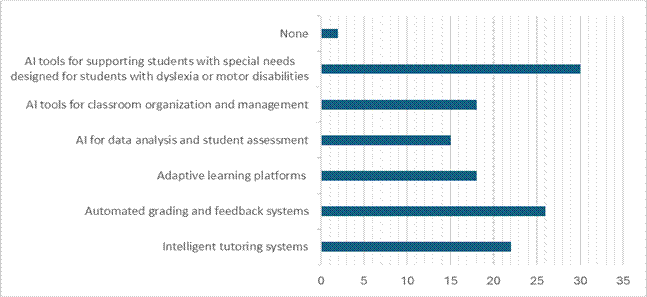
WhenFigure it comes to applications designed to support students, the list was as follows.8
AI-drivenI educationalcan games:study likefor Minecraft:an Educationhour Edition,without useusing AImy mobile phone/tablet/computer in order to createrest
scenarios where students can learn programming, math, science, and other subjects through interactive gameplay. DragonBox is an educational game that utilizes AI to tailor math challenges to the student’s knowledge level, especially helping with learning basic mathematical concepts.
AIFigure 8 presents results that suggest that most students are able to study for an hour without relying on their mobile phones, tablets, or computers to rest. 59.8% of students (combined total of Agree and Strongly Agree) feel confident in their ability to study without digital distractions. However, there is still a portion of students, 22.7% (combined total of Strongly Disagree and Disagree), who find it challenging to study for an hour without the use of these devices, possibly indicating a reliance on digital tools for learningbreaks andor problem-solving:focus. SocraticThe by17.6% Google,neutral anresponses AI appsuggest that answersfor students'some questionsstudents, andthis providesmay problemvary solutionsdepending in various subjects with tailored explanations. Photomath is an AI tool that allows students to scan math problems and receive step-by-step solutions and explanations to better understandon the material.
Language learning: Duolingo is an AI tool that personalizes lessons according to the student’s progress, adjusting the difficulty of tasks for more effective language learning. Babbel is another AI language-learning app that adapts lessons to the student’s needs and tracks progress in vocabulary and grammar.
AI tools for collaboration and teamwork: Miro provides an AI-powered platform that enables students to work in teams, brainstorm together, and visually plan projects. Padlet is an online tool using AI to facilitate collaboration, allowing students to share ideas, work, and projects in one place.
AI tools for scientific experiments and simulations: Labster, offer virtual labs and scientific experiment simulations, enabling students to explore biology, chemistry, physics, and other scientific fields. Phet Interactive Simulations uses AI-driven simulations that allow students to explore various scientific concepts and experiments in an interactive environment.
Creativity and design: Canva is an AI design tool that helps students create visually appealing projects, such as posters, presentations, and infographics, with customizable templates and elements. Animoto is an AI-powered video creation tool that allows students to make video content using templates and AI-driven effects easily.
Creative writing development: Storybird is an AI platform that guides students through creating and writing their own stories, providing ideas and visual support.
Research and information gathering: Kiddle is an AI-powered search engine tailored for children, ensuring safe and relevant results for younger students when searching for topics for their projects. Elicit is an AI tool that assists students in researching various topics by suggesting relevant articles and sources and providing summaries.
AI tools for virtual and augmented reality: Google Expeditions, an AI-powered AR and VR platform that allows students to take virtual trips and explore historical, scientific, and cultural locations.
Time management and organization: Todoist is an AI tool that helps students organize their tasks and activities by providing reminders and customizable to-do lists. MyStudyLife is an AI app that helps students track school assignments, deadlines, and exam dates, assisting them in better managing their time.
Mental health and emotional support: Woebot is an AI chatbot that provides emotional support to students, helping them manage anxiety, stress, and emotional challenges. Moodpath is an AI app that monitors students' emotional states and provides tools to better understand and manage their emotions.
As shown in Chart 6,Overall, most students (N=29)report seea thestrong potentialability ofto AI tools used for language learningfocus and scientificstudy experimentswithout anddigital simulations (N=29). This is closely followed by AI tools for Creativity and design (N=28). On the low end of the score, students don’t really see the benefits of using AI tools for research and information (N=12) and creative writing (N=6), also, one student answered „None.“interruptions.
Chart 6
Usefulness of applications designed to support students
Regarding the subjects they think should be supported by AI (Chart 7) the subject Informatics was mentioned most often (N=40).
ChartFigure 79
Digital devices often distract me while studying
UsefulnessThe results reveal that a sizable number of applicationsstudents infeel variousthat subjectsdigital devices are a source of distraction while studying. Almost 45.7% of students (combined total of Agree and Strongly Agree) believe that digital devices often interfere with their focus during study sessions. However, a larger portion of students, 30.7% (combined total of Strongly Disagree and Disagree), do not feel that digital devices are a frequent source of distraction. The 23.6% neutral responses suggest that for some students, the impact of digital devices on their focus may vary, depending on the situation. Overall, the data highlights that while many students feel distracted by digital devices, there is also a significant portion who feel that they can study without digital interruptions.
HereFigure 10
I think we learn more with the use of digital technology
The results presented in Figure 10 show a mixed but generally positive view of digital technology's role in learning. While 35.7% of students (combined total of Agree and Strongly Agree) feel that digital technology helps them learn more, a significant 31.2% (combined total of Strongly Disagree and Disagree) do not believe it contributes significantly to their learning. The 33.2% neutral responses suggest that for many students, the impact of digital technology on their learning is either unclear or not strongly felt. Overall, while many students see the value in digital tools for learning, there is also a categorizationnotable portion who do not feel that these tools make a substantial difference.
Figure 11
I find the teaching in which digital technology is used more interesting
The results in Figure 11 suggest a generally positive perception of digital technology in making lessons more interesting. A combined 50.2% of students (Agree and Strongly Agree) feel that lessons incorporating digital technology are more engaging. However, 19.1% of students (Strongly Disagree and Disagree) do not feel that digital tools make the teaching more interesting, indicating that for some, traditional teaching methods might be preferred. The 30.7% neutral responses suggest that a significant portion of students is either indifferent or does not find a noticeable difference between lessons with or without digital technology. Overall, the data highlights a strong tendency toward finding digital technology-enhanced teaching more engaging, although not all students share this view.
Figure 12
Digital technology should be used every school hour
The results show a mixed opinion on the idea of using digital technology in every school hour. A significant 45.7% of students (combined total of Strongly Disagree and Disagree) believe that digital technology should not be used on every school hour of certain subject. However, 29.6% of students remain neutral, suggesting that some students might see value in digital technology but do not feel it needs to be always used. Only a smaller portion, 24.7% (combined total of Agree and Strongly Agree), feels that digital technology should be integrated into every school hour. Overall, the data suggests that while many students see the value of digital technology, they do not believe it should be overused or incorporated into every lesson.
Figure 13
Digital technology should be used during complete lesson
Results presented in Figure 13 suggest that most students do not feel digital technology should be used during complete lesson. Majority of 63.3% students (combined total of Strongly Disagree and Disagree) believe that digital technology should not be continuously used throughout lesson. A smaller portion, 13.5% (combined total of Agree and Strongly Agree), supports the idea of using digital technology during complete lesson, but this group is relatively small. The 23.1% neutral responses suggest that some students may feel that digital technology could be used at certain times but not necessarily all the time. Overall, the data indicates a clear preference for using digital technology in moderation, rather than consistently throughout complete lesson.
Figure 14
Digital technology should be used occasionally
Figure 14 display results that indicate a strong preference for the occasional use of digital technology. A total of 66.9% of students (combined total of Agree and Strongly Agree) feel that digital technology should be used in moderation, specifically on an occasional basis. On the other hand, only 11.0% of students (combined total of Strongly Disagree and Disagree) disagree with statement that digital technology should be used occasionally. The 22.1% neutral responses suggest that some students may not have strong feelings on the matter, but the overall trend shows that most students prefer a balanced approach, with digital technology used occasionally rather than constantly.
Figure 15
I am happy when at school we get the task of recording an educational video ourselves
The results presented in Figure 15 show that a large portion of students, 57.1% (combined total of Strongly Disagree and Disagree), does not enjoy the task of recording an educational video, with many finding it less appealing. However, a smaller group, 24.3% (combined total of Agree and Strongly Agree), enjoys that type of task. Only 18.7% of students were neutral, indicating that for some students, the activity does not evoke strong feelings either way. Overall, while a minority of students find recording educational videos enjoyable, the majority do not feel particularly happy about this task.
Figure 16
I easily create my own digital content (video, presentation, digital poster, etc.)
Figure 16 presents results that indicate that most students feel confident in their ability to create digital content. A combined 69.2% of students (Agree and Strongly Agree) report being able to easily create content like videos, presentations, and digital posters. However, 13.2% (combined total of Strongly Disagree and Disagree) find it difficult to create digital content, indicating some challenges in this area. The 17.7% neutral responses suggest that for some students, the ability to create digital content may vary depending on the task or situation. Overall, the data shows that the majority of students are confident in their ability for digital content creation, but a small group faces difficulties.
Figure 17
I try harder when we get a task in which we need to use digital technology (record a video, make a presentation, digital poster, etc.)
The results in Figure 17 suggest that a significant number of students feel more motivated to try harder when tasks involve digital technology. A combined 51.0% of students (Agree and Strongly Agree) report that they put in more effort when digital technology is part of the providedtask. textHowever, into18.7% (combined total of Strongly Disagree and Disagree) do not feel more motivated by the use of digital tools. A sizable 30.3% of students were neutral, suggesting that for some students, the type of task or other factors may play a fewmore keyimportant categories:
1.than Positivethe Impactsuse of AIdigital ontechnology. Education:
Easewhile ofmany Usestudents find digital technology motivating, it does not seem to be a universal motivator for Teachers:all AI will likely facilitate the preparation of materials and assignments, reducing the workload for teachers. Teachers will be able to track and evaluate student progress more easily and make their classes more engaging.
Enhanced Learning Tools: More tools will make learning more interesting both in class and independently. AI will provide personalized learning, adapting to each student's pace, interests, and needs, helping students with different abilities to progress better.
Administrative Automation: AI will automate administrative tasks like grading and progress tracking, reducing the burden on teachers.
Interactive Learning for Abstract Concepts: AI will help explain complex topics visually, especially in subjects like natural sciences.
Increased Efficiency: AI can make teaching more efficient and lessen the burden on teachers, making classes more effective and fun.students.
2. Negative Impacts of AI on Education:Conclusions
Over-reliance on AI: Both teachers and students may become too dependent on AI, leading to a reduction in independence and creativity. Over-reliance on AI might diminish critical thinking skills and logical reasoning among students.
DecreasedThis Teacherstudy Involvement:highlights the diverse perspectives of primary school students regarding the integration of ICT in their education. The rolefindings reveal that while students generally appreciate the use of teachersdigital mighttechnology in the classroom, their preferences, experiences, and challenges vary significantly. Many students recognize the benefits of ICT in making learning more engaging, interactive, and effective, particularly through tools like digital quizzes, games, and adaptive platforms. However, a considerable number of students expressed neutral or mixed feelings about the extent of ICT usage, with some preferring traditional methods for certain aspects of learning.
Students largely favor a balanced approach to ICT integration, with occasional use being seen as most effective. While many students feel confident in creating digital content and report increased motivation for tasks involving digital tools, others find prolonged screen time or excessive use of technology to be diminished,less withdesirable. AIThese toolsfindings handling tasks that were previously teacher-led, potentially leading to a decrease inunderscore the importance of thetailoring teacher-studentICT relationship.use to individual and group needs, ensuring it complement rather than overwhelms traditional teaching methods.
Laziness and Reduced Critical Thinking: Students might rely on AI to complete assignments, leading to a lack of effort and reduced engagement in learning. AI might encourage a „shortcut“ mentality, where students seek easy solutions rather than learning and problem-solving.
ReducedTo Socializationmaximize the benefits of ICT in primary education, it is crucial to address key challenges, including minimizing digital distractions, bridging the digital divide, and Communication:ensuring Thethat educators are adequately trained to integrate technology effectively. Future research should explore the long-term impacts of ICT on students' learning outcomes and well-being, as well as investigate strategies to optimize its use ofin AIfostering maycritical leadthinking, to less social interactioncreativity, and communicationcollaboration. amongBy students,adopting affectinga theirthoughtful, socialinclusive skillsapproach, ICT can serve as a powerful tool for enhancing educational experiences and abilitypreparing tostudents focus.for the demands of a digital world.
3. Mixed Impacts and Concerns:References
BalanceAlthubyani, betweenA. BenefitsR. (2024). Digital Competence of Teachers and Risks:the WhileFactors AIAffecting canTheir provideCompetence valuableLevel: toolsA forNationwide learning,Mixed-Methods especiallyStudy. in areas where schools lack resources (e.g.Sustainability, science labs)16(7), there is concern about maintaining emotional and human interaction in education, which is crucial for child development.2796.
NeedDingli, S., Baldacchino, L. (2018). Creativity and digital literacy: skills for Gradualthe Implementation: Technology should be introduced gradually to avoid negative impacts on critical thinking and ensure that AI enhances rather than replaces human elements in education.future.
Rodriguez-Jimenez,
C.,4.de Skepticismla andCruz-Campos, Caution:
SkepticismC., towardCampos-Soto, AIM. Integration:N., Many& fearRamos-Navas-Parejo, thatM. the(2023). integration of AI will lead to a loss of key educational values, such as creativity, problem-solving, and personal development. Some believe AI will lead to laziness and a lack of effort in both teachingTeaching and learning processes.mathematics in primary education: The role of ICT-A systematic review of the literature. Mathematics, 11(2), 272.
PotentialKangas, for Negative Long-term Effects: Some express concern that the long-term impact of AI will be a decrease in socialization and hands-on learning, with children becoming overly reliant on technology for solutions.
Conclusion
In conclusion, this study examined the attitudes of prospective primary school teachers towards the use of AI in education, focusing on three hypotheses. The first hypothesis proposed that there are no statistically significant differences in opinions and attitudes based on the students' year of study. The results partially supported this hypothesis, as some differences were found across study years, particularly regarding the perception of AI’s role in supporting students with special needs and facilitating lesson planning. Therefore, it was concluded that the year of study has only a minor influence on shaping attitudes and opinions, as the observed differences were not consistent across all evaluated categories.
The second hypothesis suggested that there are no statistically significant differences in opinions based on the students' study module. This hypothesis was also partially confirmed, as students from the Informatics module exhibited significantly more positive attitudes towards AI compared to those from the language and arts modules. Nevertheless, no significant differences were found between Informatics and some other modules, such as Educational Sciences, highlighting a subtle connection between the study module and attitudes toward AI.
The third hypothesis, which stated that there are no statistically significant differences between the average ratings of positive and negative aspects of AI in teaching, was refuted. The results indicated a statistically significant difference, with students rating the negative aspects of AI—such as concerns about critical thinking, creativity, and ethical implications—more strongly than the positive aspects, such as AI’s potential to improve learning efficiency and support personalized education.
Overall, what these findings show is the complexity of integrating AI into education. Prospective teachers not only see the potential benefits of using AI with students but also are very cautious about the possible drawbacks. They worry about the potential impact of creative AI on the kind of work that students do and on the kinds of decisions that teachers make about the kind of work that students do. And they especially worry about the kind of impact that creative AI could have on student autonomy.
Literature
Harry, A.K., & Sayudin, S. (2023). Role of AI in Education. Interdiciplinary Journal and Hummanity (INJURITY), 2(3), 260-268.
Alneyadi, Saif, Wardat, Yousef, Alshannag, Qasim, & Abu-Al-Aish, Ahmad. (2023). The effect of using smart e-learning app on the academic achievement of eighth-grade students. EURASIA Journal of Mathematics, Science and Technology Education, 19(4), em 2248.
HolonIQ. (2023). Artificial intelligence in education: 2023 survey insights. HolonIQ. https://www.holoniq.com
Sutaria, N. (2022). Bias and ethical concerns in machine learning. ISACA J., 4, 1-4.
McNulty, N. (2023). AI data privacy in schools: Navigating the challenges and solutions. Retrieved from https://www.niallmcnulty.com
GUJJULA, R., & Sanghera, K. (2023). Ethical Considerations and Data Privacy in AI Education. Journal of Student-Scientists' Research, 5.
UNESCO. (2023). The challenges and opportunities of artificial intelligence in education. UNESCO. https://www.unesco.org
Baker, R. S., & Hawn, A. (2022). Algorithmic bias in education. International Journal of Artificial Intelligence in Education, 32, 1052–1092.
Chaudhuri, S., & Mohanty, I. (2023). The importance of bias mitigation in AI: Strategies for fair, ethical AI systems. UXmatters.
ICO. (2023). What about fairness, bias and discrimination? ICO.
Ibrahim, Hamza Khalifa, Al-Awkally, Noor Alhooda Milood, Samad, Abdul, Zaib, Waqar, & Hamza, Muhammad. (2022). Covid-19 Pandemic and Its Impact on Psychological Distress, Malignancy and Chronic Diseases: A Scoping Review. Eduvest-Journal Of Universal Studies, 2(5), 1017–1021.
Gningue, S. M., Peach, R., Jarrah, A. M., & Wardat, Y. (2022). The Relationship between Teacher Leadership and School Climate: Findings from a Teacher-Leadership Project. Educ. Sci. 2022, 12, 749.
Alarabi,Sormunen, K., & Wardat, Y. (2021). UAE-based teachers’ hindsight judgments on physics education during the COVID-19 pandemic. Psychology and Education Journal, 58(3), 2497–2511.
Calibraint. (2023). AI in Education: A Comprehensive Guide to Benefits and Applications.
Niall McNulty. (2023). AI predictive analytics for education: Transforming learning outcomes. Retrieved from https://www.niallmcnulty.com
Calibraint. (2023). AI in education: A comprehensive guide to benefits and applications. Retrieved from https://www.calibraint.com
Benzakour, A., Altsitzioglou, P., Lemée, J. M., Ahmad, A., Mavrogenis, A. F., & Benzakour,Korhonen, T. (2022). ArtificialCreative intelligencelearning with technologies in spineyoung surgery.students’ STEAM education. In InternationalSTEM, OrthopaedicsRobotics, Mobile Apps in Early Childhood and Primary Education: Technology to Promote Teaching and Learning (pp. 157-179). Singapore: Springer Nature Singapore.
Kurilovas,Lara E.Nieto-Marquez, N., Baldominos, A., Cardena Martinez, A., & Perez Nieto, M. A. (2018)2020). AdvancedAn machineexploratory analysis of the implementation and use of an intelligent platform for learning approachesin toprimary personalize learning: Learning analytics and decision making.education. BehaviorApplied andSciences, Information10(3), Technology.983.
Chiu,Saif, T. K. F., Xia, Q., Zhou, X., Chai, C.A. S., &Mahayuddin, Cheng,Z. M. (2023). Systematic literature review on opportunities, challenges, and future research recommendations of artificial intelligence in education. Computers and Education: Artificial Intelligence.
Chaudhuri, S.R., & Mohanty, I. (2023). The importance of bias mitigation in AI: Strategies for fair, ethical AI systems. UXmatters.
Malik,Shapi'i, A. (2024)2021). AddressingAugmented biasreality inbased AI:adaptive Strategiesand collaborative learning methods for biasimproved mitigationprimary witheducation OpenAI.towards Signityfourth Solutions.
AIWS.revolution (2023).IR Revolutionizing learning: The advantages of AI intelligent tutoring systems. AI World School. https://aiworldschool.com
Fernández-Herrero, J. (2024). Evaluating recent advances in affective intelligent tutoring systems: A scoping review of educational impacts and future prospects. Education Sciences, 14(8), 839. https://doi.org/10.3390/educsci14080839
Kurni, M., Mohammed, M. S., & Srinivasa, K. G. (2023). Intelligent tutoring systems. In A beginner's guide to introduce artificial intelligence in teaching and learning (pp. 29-44). Cham: Springer International Publishing.
Alharbi, W. (2024). Mind the gap, please! Addressing the mismatch between teacher awareness and student AI adoption in higher education4.0). International Journal of Computer-AssistedAdvanced LanguageComputer LearningScience and TeachingApplications, (Mind-the-Gap-Please!_-A…)12(6).
Beović, E. (2023). Theoretical Approaches to Teacher Training in Primary Education. University of Zadar.
Felix, C. V. (2020). The Role of the Teacher and AI in Education. International Perspectives on the Role of Technology in Humanizing Higher Education (Chapter_3_The_Role_of_t…).
Guilherme, A. (2017). AI and education: The importance of teacher and student relations. AI & Society.
Kim, J. (2023). Leading teachers' perspective on teacher-AI collaboration in education. Education and Information Technologies (Kim2023.Leadingteachers…).
Pejnović, L. (2024). The Use of AI in the Education System and Its Potential Consequences. University of Zagreb.
Wang, X., et al. (2023). Preparing for AI-enhanced education: Conceptualizing and empirically examining teachers’ AI readiness. Computers in Human Behavior.
Cope, B., Kalantzis, M., & Searsmith, D. (2020). Artificial intelligence for education: Knowledge and its assessment in AI-enabled learning ecologies. Educational Philosophy and Theory. https://doi.org/10.1080/00131857.2020.1728732​
Holmes, W., & Tuomi, I. (2022). State of the art and practice in AI in education. European Journal of Education, 57(4), 542-570 (Euro J of Education - 2…).
Luckin, R., Holmes, W., Griffiths, M., & Forcier, L. B. (2016). Intelligence Unleashed: An Argument for AI in Education. Pearson.
Perrotta, C., & Selwyn, N. (2019). Deep learning goes to school: toward a relational understanding of AI in education. Learning, Media and Technology.
Su, J., & Yang, W. (2023). Unlocking the power of ChatGPT: A framework for applying Generative AI in education. ECNU Review of Education.
Carnegie Learning. (2024). MATHia® by Carnegie Learning Wins “Best Artificial Intelligence Solution” in The EdTech Awards 2020. Business Wire.
Khan Academy. (2023). How We Built AI Tutoring Tools - Khan Academy Blog.
Edmentum. (2020). AI-Driven Data Analytics for Personalized Learning.
Tsirulnikov, D., Suart, C., Abdullah, R., Vulcu, F., & Mullarkey, C. E. (2023). Game on: immersive virtual laboratory simulation improves student learning outcomes & motivation. FEBS Open bio, 13(3), 396-407.
Fitzpatrick, K. K., Darcy, A., & Vierhile, M. (2017). Delivering cognitive behavioral therapy to young adults with symptoms of depression and anxiety using a fully automated conversational agent (Woebot): A randomized controlled trial. JMIR Mental Health, 4(2), e19.
Karsen, M., Pangestu, H., & Kristin, D. M. (2022, August). Acceptance of Miro and Padlet as Collaboration Tools on Hybrid Flipped Learning & Case-Based Learning in Education 4.0 (a case study approach). In 2022 International Conference on Information Management and Technology (ICIMTech) (pp. 577-582). IEEE.
Holmes, W., & Tuomi, I. (2022). State of the art and practice in AI in education. European Journal of Education.
D'Mello, S. K., & Graesser, A. (2023). Intelligent tutoring systems: How computers achieve learning gains that rival human tutors. In Handbook of educational psychology (pp. 603-629). Routledge.
Zain, I. N., Setambah, M. A., Othman, M. S., & Hanapi, M. H. (2023). Use of Photomath Applications in Helping Improving Students’ Mathematical (Algebra) Achievement. European Journal of Education and Pedagogy, 4(2), 85-87.
Alawajee, O., & Delafield-Butt, J. (2021). Minecraft in education benefits learning and social engagement. International Journal of Game-Based Learning (IJGBL), 11(4), 19-56.
Su, J., & Yang, W. (2023). Unlocking the power of ChatGPT: A framework for applying generative AI in education. ECNU Review of Education, 6(3), 355-366.
Kostrić, M. (2021). AI in early childhood education: Opportunities and challenges. University of Zagreb.
Modrušan, A. (2023). The impact of artificial intelligence on the teaching profession: Opportunities and challenges. University of Zagreb.
Kessler, M., Loewen, S., & Gönülal, T. (2023). Mobile-assisted language learning with Babbel and Duolingo: comparing L2 learning gains and user experience. Computer Assisted Language Learning, 1-25.
Belda-Medina, J., & Goddard, M. B. (2024). AI-Driven Digital Storytelling: A Strategy for Creating English as a Foreign Language (EFL) Materials. International Journal of Linguistics Studies, 4(1), 40-49.
Bouchrika, I. Best School Organization Apps for Time Management, Note-Taking & Mind Mapping in 2024.

